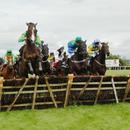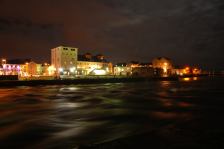athenry
A Minefield of Medieval Delight: Athenry
By Eimear Laffan , 14 Aug 2002
 |
|
Athenry Castle |
`Cross', `Abbey' and `Church' are all street names that you will encounter in Athenry ostensibly indicative of a rich ecclesiastical past. While this is the case to a certain extent, its' claim to fame lies in the history of old, with a group of warriors widely renown for their strength and fierceness. While one can roam freely and in a relaxed manner around the streets today, there was nothing relaxing about how the natives were treated by the invading warriors. What better place to obtain a crash course in medieval Ireland than Athenry, which witnessed the arrival of the Anglo-Normans in the late 12th century and where its rich historical past can still be seen today.
The first Normans arrived in Ireland in Co. Wexford in 1169. But it was the Anglo-Normans, who came to Connaught under the direction of the King of England, Henry the II, that left their legacy on this countryside. The Lord of Connaught, Richard de Burgo, had conquered Connaught with significant help from the de Birmingham's. Meiler de Birmingham, the 2nd Baron of Athenry, was consequently granted much of the land in this area in 1235. It was here that the principal seat of the de Birmingham's was established and here where Melier choose to build a stone castle and town at a ford on the River Clareen. Indeed, Athenry takes its name from the Gaelic `Baile Atha-an-Ri' meaning `King's ford'.
Believed to have been erected in 1238, the castle is the earliest building still standing, restoration works having been completed in 1993. The castle takes the more common rectangular shape of the time. Now consisting of a 3-storey keep, surrounded by an outer wall, its construction was completed in 3 stages. The roof was raised to accommodate a second storey in 1250 and again at some point during the 15th century when there was a nationwide revival in the building of castles and churches.
 |
|
Orange & Pablo the pony. Carriage tours around Athenry. |
Today you enter the castle by a series of external wooden steps, that lead to the first floor. The interior itself is not decorated although the wooden floors and roof of the attic would make a perfect attic apartment, albeit with small slit windows specifically designed for the shooting of arrows. The locals, I dare say, would not be impressed and rightly so considering that this is the only fully restored Norman castle in the country. The highlight of the visit is a 20-minute film. Presumptuously awaiting some rendition about the Normans or the castle itself, this is more of a pitch to tourists managing to show several abbeys, churches, and flowers, all accompanied by some good hearty traditional Irish music. They even managed to include a depiction of the landscape of the Burren (if there is some connection between the Burren and this Norman castle, I stand corrected). In addition to the castle, Melier de Birmingham was also responsible for the building of the church of St. Mary's shortly after as a place of worship for his followers.
 |
|
Athenry Heritage Centre |
The external wall that surrounds the castle resemble another. Walls were erected around the town enclosing an ambitious 85 acres of land. This was in response to the Battle of Athenry in which the de Burgo's joined the de Birmingham's in defeating an attack by the Irish under the tutelage of Felim O' Connor. Up to 8,000 people are believed to have been killed in a single day. Over 80% of the original wall is still standing along with one of its original gates. The primary function of both walls was to keep the `barbarian' Irish out.
In addition to the castle, other attractions include a Heritage Centre, a friary and a market cross. Community run, the Heritage Centre is open 7 days from April-September only. It chronicles the history of the town, and houses a reconstruction of a medieval market place. There is even the opportunity to dress up in medieval costume and for the more adventurous you can try your hands at archery at certain times. While the remnants of Athenry's rich medieval past echo through its buildings, some things remain the same and on entering the Heritage Centre, it seemed appropriate that the near by church bells should begin to ring.
The Dominican friary of St. Peter and Paul was founded in 1241 and while not restored its skeleton is still intact. This building has had an illustrious past serving at various times as an army barracks and a university. Several 17th century graves with Celtic designs dot the grounds and are well worth a peak.
The Market Cross was put in place to mark the spot as a trading area. It is the only one in Ireland that has maintained it original position since ancient times. While originally made of wood, the current cross is stone and dates from the 15th century. It has a representation of the crucifixion on one side and that of the Virgin and child on the other.
 |
|
Market Cross, Athenry |
Easily accessible lying just 24kms east of Galway city, Athenry makes for an ideal day trip. It lies on the main Galway-Dublin train line and if you don't have your own transport this is the most convenient way of getting here. It has to be one of the easiest places in the world to navigate with all the main attractions in close proximity and easily reachable by foot. Perhaps the Normans had a certain intelligence to accompany their legendary zeal as it is believed that the street lay out has not changed significantly over time. Given the ease of navigation, the highlights of Athenry can be seen in a relatively short period of time.
Athenry was indicative of many medieval towns of old in having a castle, a church, fortified walls, planned streets and a market place. Today, it is its unparalled sustenance of some of these things that makes it unique and a necessary visit for anyone with an interest in the past.
Releated Links
-
Accommodation in Athenry
http://www.galway.net/galwayguide/acc/byarea/athenry/








 A labrador watches the sunset at Salthill, Sunday 6 April 2003. Photo: Joe Desbonnet
A labrador watches the sunset at Salthill, Sunday 6 April 2003. Photo: Joe Desbonnet
 Claddagh at night. Photo: Joe Desbonnet
Claddagh at night. Photo: Joe Desbonnet